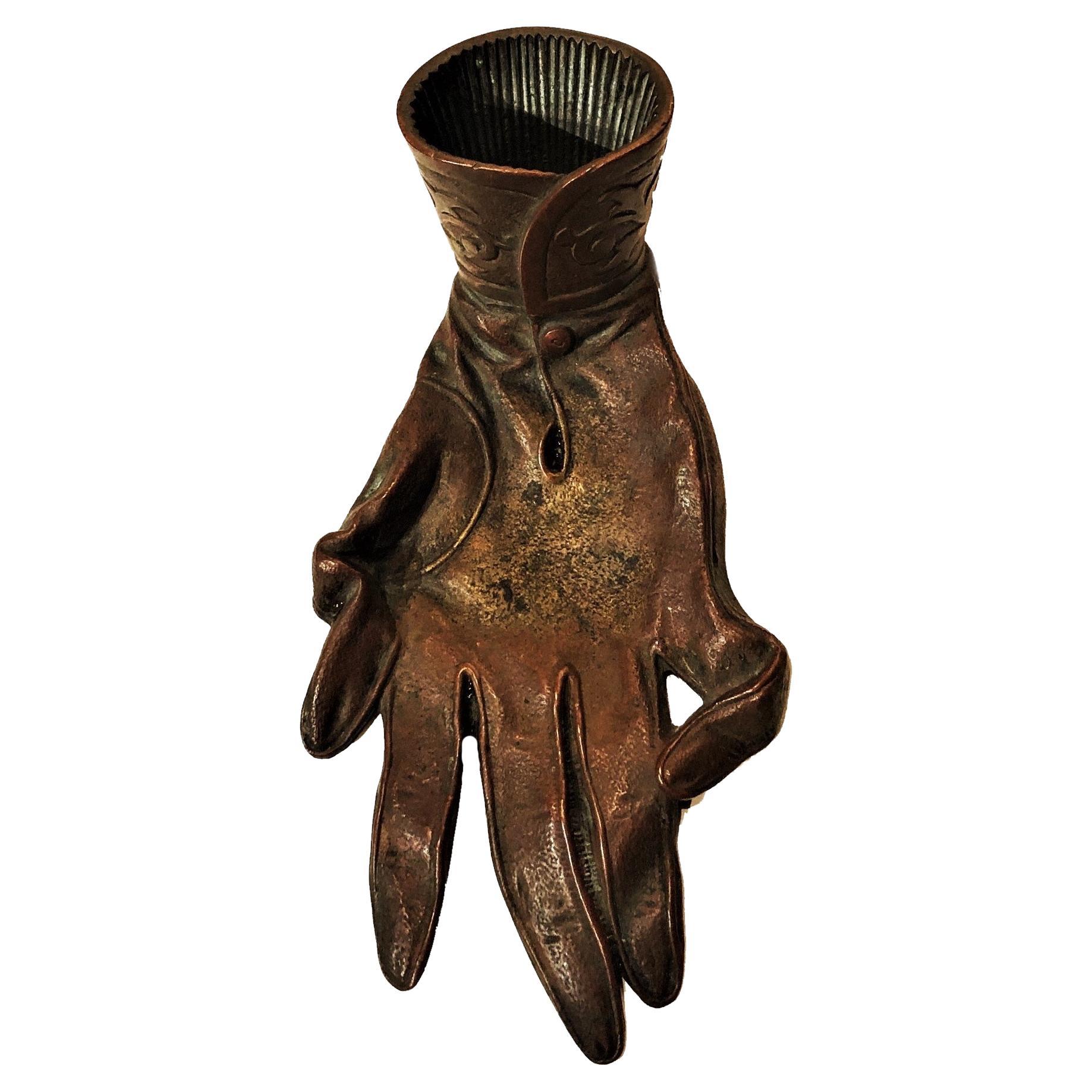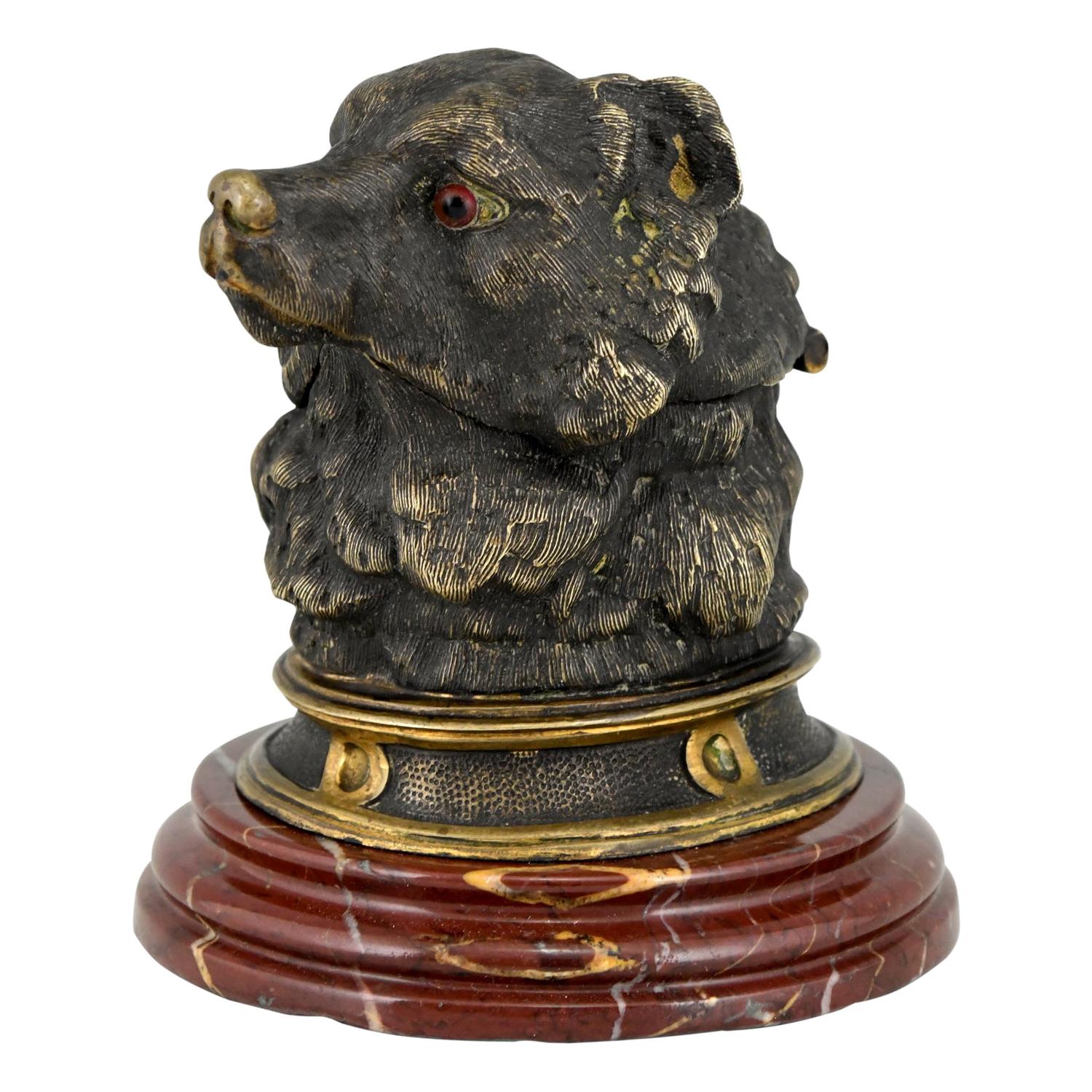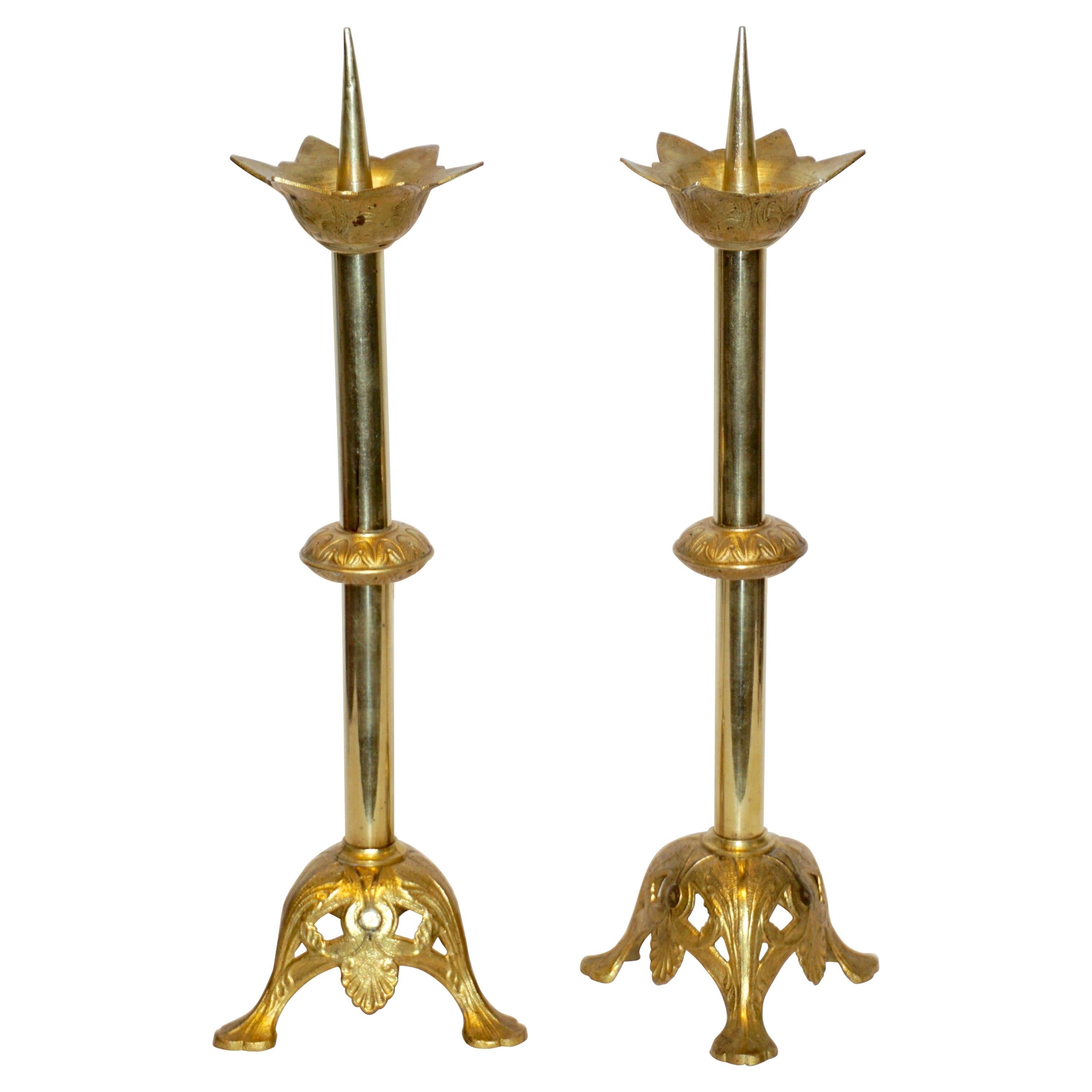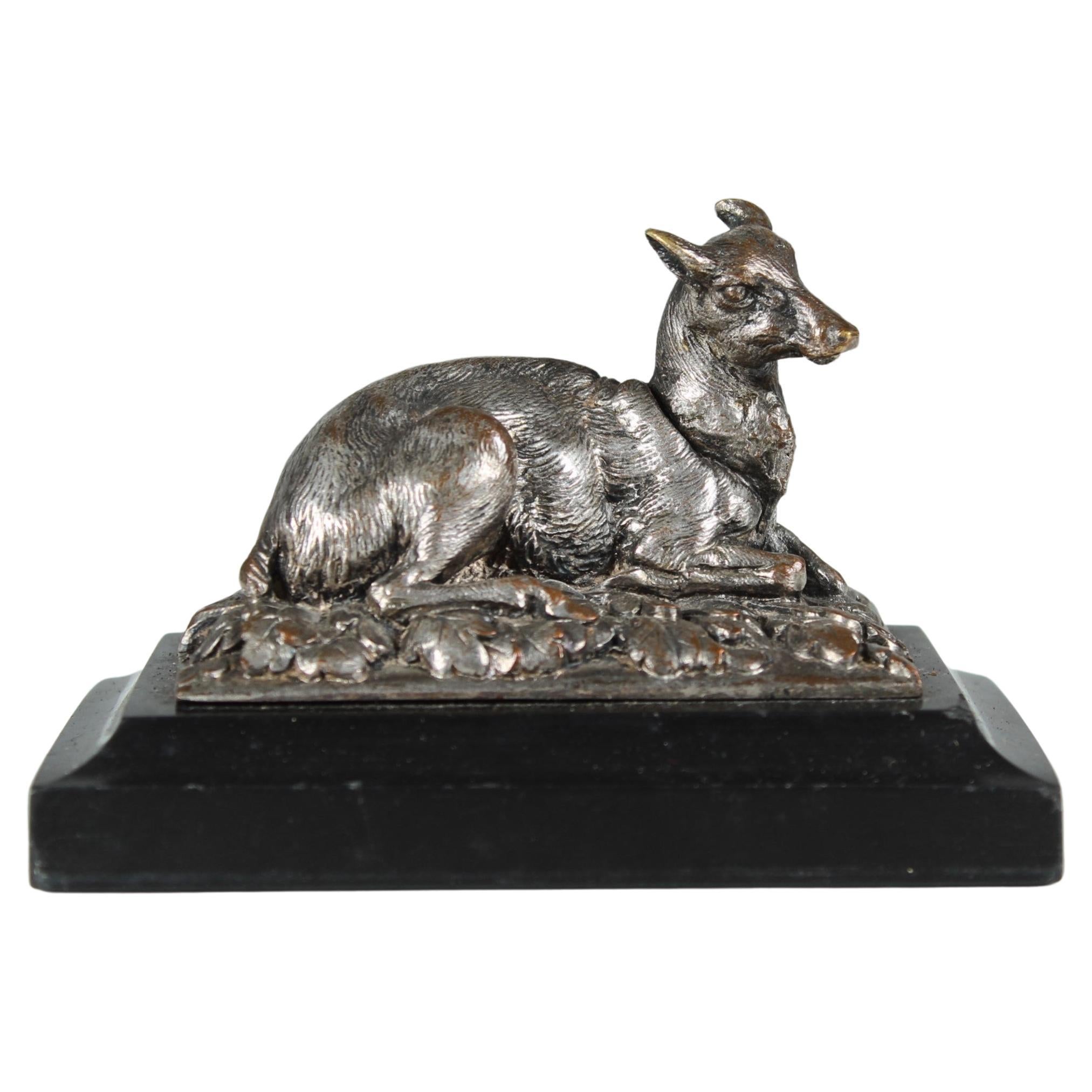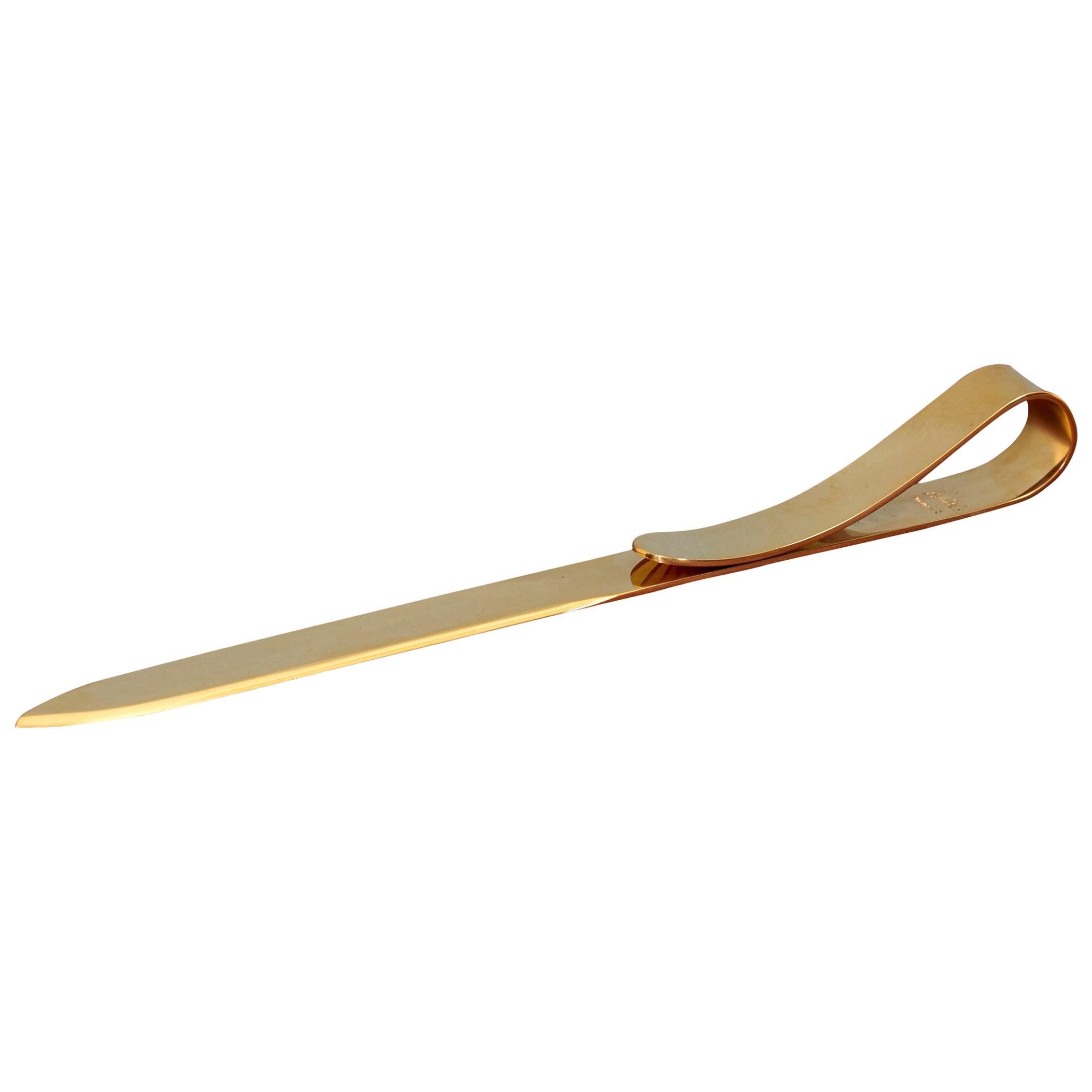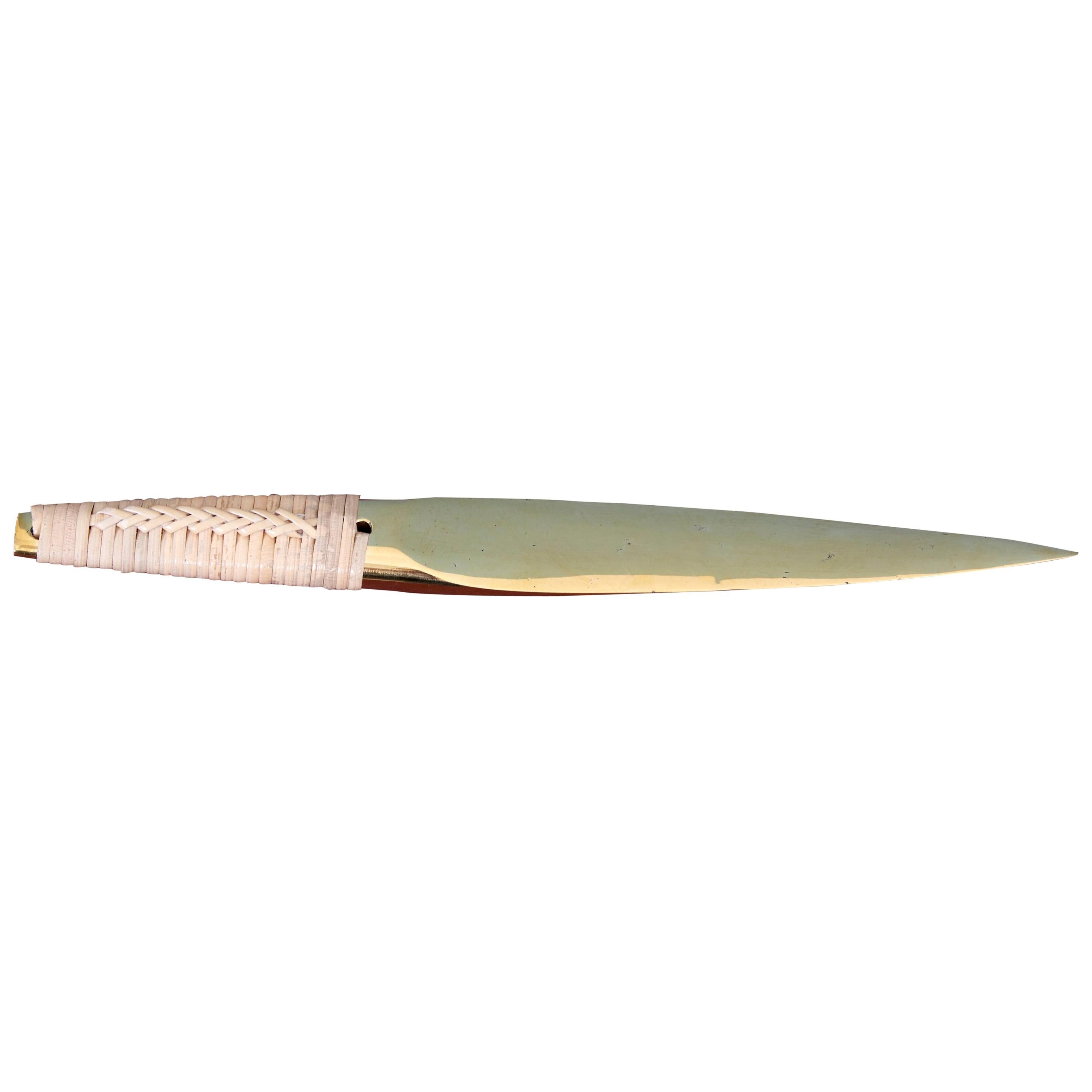Items Similar to Alfredo Castellani Att., Bronze & Marble Paperknife, ca. 1880s
Want more images or videos?
Request additional images or videos from the seller
1 of 17
Alfredo Castellani Att., Bronze & Marble Paperknife, ca. 1880s
About the Item
Attributed to
Alfredo Castellani
Paperknife
Patinated Bronze & Marble
Italy, ca. 1880s
ABOUT
These Castellani paper cutters, paperknives or letter openers were quite popular in the second half of the 19th century. Winged figures of angels, devils, and, in this case putty, were made in various materials such as silver, bronze, ivory or wood. They all have the distinctive pointed wings with a small slit in the middle.
Designed probably by Michelangelo Gaetani for Alfredo Castellani, this most unusual paperknife depicts a winged angel standing on a marble ball. What gives this knife a special originality is the mysterious position of the putto’s arms, similar to the embrace of someone unknown, absent. However, this was done with the express purpose of giving the knife maximum functionality and ease of use. In fact, the hugging arms are designed for the thumb of the right hand and precisely calculated to the natural position of the fingers when gripping the handle of this remarkable knife.
DIMENSIONS
Height: 8.33 inches
Width: 1.75 inches
Depth: 1.5 inches
ALFREDO CASTELLANI (Italian, 1853-1930)
The Castellani family (Fortunato Pio, Alessandro, Augusto and Alfredo) is known mainly as jewelers, but also as ceramicists, collectors and antique dealers. Active in Rome as of 1814, they were famous primarily for the creation of jewelry inspired by Greek, Roman, Etruscan, Medieval and Renaissance pieces. Their jewelry and other objects were modeled after in-depth studies on goldsmith techniques, especially those used by the Etruscans, whose tombs in Tuscany and Lazio were discovered during the excavations that took place at the time.
The products made by the Castellani family were so popular that they opened branches in Naples, London and Paris. Today, their work can be admired in museums around the world, including the National Etruscan Museum at Villa Giulia in Rome and the Victoria & Albert Museum in London. The day after 20 September 1870 (the Capture of Rome), Augusto Castellani (1829-1914) helped found the Municipal Archaeological Commission of Rome. He was also among the organizers of the Artistic Industrial Museum of Rome (Museo Artistico Industriale), and served as the Director of the Capitoline Museums.
The archive was donated to the Library in 1930 in accordance with the will of Alfredo Castellani (1853-1930), the family's last heir. Though not particularly numerous, it is mainly made up of publications from the late 19th century on archaeology, history, applied arts and goldsmith craft. The presence of valuable 19th-century periodicals, especially those relating to Rome, is worth noting. The collection of booklets and brochures, despite their occasional nature (exhibition catalogues, assembly minutes, laws and regulations regarding jewelry) is more homogeneous and attests to the family's interest in antiques, ornamentation, goldsmith craft and ceramics.
Castellani was the Italian jeweler who initiated the archaeological revival movement in the mid-nineteenth century. Castellani’s founder, Fortunato Pio Castellani, opened up shop in Rome in 1814. In 1826, he met his lifelong friend and collaborator Michaelango Caetani at a lecture where he was speaking about how to recreate the look of ancient gold. According to jewelry historians, Caetani “gave Fortunato Pio the idea to imitate and seek inspiration from Ancient jewelers.”
Caetani was a Dante scholar, a historian, a talented woodworker and an artist familiar with jewelry manufacturing techniques. He was also a darling of Roman high society. Though Caetani was never formally employed by the firm, his creativity and connections helped the Castellanis to prosper.
By the early 1830s, Fortunato Pio had begun making archaeological-style jewelry. In 1836, when the Etruscan Regolini-Galassi tombs were opened, papal authorities invited him to study the jewellery found there. In the 1840s and ’50s, he and his sons, Alessandro and Augusto, were also given access to the huge collection of antiquities acquired by the director of the papal savings bank, Marchese Fiolanni Pietro Campana. While now dispersed, the Campana collection was then complete and at the Castellanis’ fingertips. They realized that the ancients created their designs by adding detail to the metal rather than carving, punching, cutting, and otherwise deforming the metal to create an effect. They were able to recreate the look and feel of these Ancient pieces using granulation, wirework, and other old-style gold working techniques. Such techniques had been seemingly lost for centuries until the brothers discovered a remote area of the Apennines where they were still being practiced.
In the 1860s, Castellani vaulted into fame as popular fascination with archaeological finds grew. Exiled from Rome due to his political views in 1860, Alessandro (the older Castellani brother) busied himself with marketing the firm’s jewelry abroad. First setting up shop on the Champs Elysées in Paris, he lectured widely on Ancient jewelry and socialized with Parisian high society, even gaining a presence with Napoleon III, to whom he presented a collection of Castellani jewelry. Alessandro also organized the firm’s first displays at international exhibitions: Florence (1861) and London (1862). In 1862, he left Paris after having an affair with, and impregnating, a married woman. He moved to London and, shortly thereafter, to Naples, where he set up his own jewelry workshop.
The firm is also known for incorporating ancient, medieval, and modern intaglios and cameos, as well as Egyptian scarabs and micro-mosaics into their pieces. According to jewelry historians, the firm was the first to place micro-mosaics, often with Early Christian, Byzantine, and Egyptian designs, in archaeological style frames.3 Luigi Podio was the master mosaicist for the famed archaeological revival jeweler. Podio’s workshop in Rome created some of the finest and most detailed mosaics of the period. The higher quality and exquisite detail of the mosaics in Podio’s workshop rose well above the coarser production of his peers. Podio supervised the mosaic studio from 1851 to 1888.
The firm’s designs continued to be wildly popular. At the 1867 international exhibition in Paris, “nearly all” of the jewelers featured Archaeological-style jewels in their showcases.
The firm’s success peaked in the 1870’s. In the 1880’s, the Rome location was handed over to Augusto’s son, Alfredo. Until his death in 1914, Augusto busied himself with, among other things, attempting to “document the progression of Italian goldsmith art from pre-historical times to the present.”
He suggested eight time periods: primitive, Tyrrhenian, Etruscan, Sicilian, Roman, medieval, Renaissance, and modern. Though his categories are not accepted as exhaustive today, it was one of the first modern attempts to divide the history of jewelry design into eras.
In 1930, Castellani closed its doors when Alfredo, the last in the line of Castellani jewelers, died.
- Dimensions:Height: 8.33 in (21.16 cm)Width: 1.75 in (4.45 cm)Depth: 1.5 in (3.81 cm)
- Style:Renaissance (In the Style Of)
- Materials and Techniques:Bronze,Cast
- Place of Origin:
- Period:
- Date of Manufacture:ca. 1880
- Condition:Wear consistent with age and use. We make our best effort to provide a fair and descriptive condition report. Please examine photos attentively for they are an important part of the description. Send us a message to request more details or discuss price. 55.
- Seller Location:New York, NY
- Reference Number:1stDibs: LU2819336536452
About the Seller
5.0
Vetted Seller
These experienced sellers undergo a comprehensive evaluation by our team of in-house experts.
Established in 1993
1stDibs seller since 2017
68 sales on 1stDibs
Typical response time: 2 hours
- ShippingRetrieving quote...Ships From: New York, NY
- Return PolicyA return for this item may be initiated within 10 days of delivery.
More From This SellerView All
- French Belle Epoque Tromp L'éoel Bronze Paperweight Ashtray, ca. 1880sLocated in New York, NYBelle Epoque ~ Tromp L'éoel Paperweight Ashtray w/ Cigarette & Match-Striker Holder in form of a Glove Patinated Bronze France, ca. 1880s ABOUT Made in France in the last quart...Category
Antique 1880s French Belle Époque Paperweights
MaterialsBronze
- Opus-Cellini, Art Deco Bronze and Marble Sculptural Paperweight, ca. 1930By Opus Cellini Bronze WorksLocated in New York, NYMarked "Opus-Cellini" in the back, this remarkable American Art Deco desk-size gild and dark-patinated bronze and marble sculptural paperweight, depicting a comfortably resting beautiful nude female was made circa 1930 by the famous American founder, Cellini bronze...Category
Vintage 1920s American Art Deco Paperweights
MaterialsMarble, Bronze
- Franz Bergmann, Viennese Bronze & Marble Erotic Sculptural Vide Poche, ca. 1900By Franz BergmannLocated in New York, NYDimensions: Height (w/ skirt down): 6.75 inches (17cm). Height (w/ skirt up): 8.5 inches (21.25 cm). Diameter of marble base: 6.25 inches (15.63 cm). ...Category
Antique Early 1900s Austrian Art Nouveau More Desk Accessories
MaterialsBronze
- Art Deco Bronze and Green Agate Sculptural Vide Poche, ca. 1920sLocated in New York, NYUnmarked, probably Austrian, this charming carved green agate octagonal vide poche with green/black patinated bronze handle is done in the manner of Hagenauer - a superbly detailed a...Category
Vintage 1920s Austrian Art Deco Paperweights
MaterialsAgate, Bronze
- Austrian Jugendstil Vienna Bronze Sculptural Paperweight by Carl Fiala, ca. 1910Located in New York, NYABOUT This elegant Austrian Jugenstil sculptural desk paperweight depicts some fantastic half-human creature from the underwater world, riding a snail. Signed C. Fiala, dark-green co...Category
Vintage 1910s Austrian Jugendstil Paperweights
MaterialsBronze
- Chinese Art Deco Enameled Bronze Inkwell w/ Bird and Flower Motif, ca. 1920Located in New York, NYChinese Art Deco Enameled Bronze Inkwell w/ Bird and Flower Motif ca. 1920 Dimensions: Height: 2.5 inches. Width: 6.75 inches. Depth: 3.5 inches.Category
Vintage 1920s Chinese Art Deco Inkwells
MaterialsBrass
You May Also Like
- Antique Bronze Inkwell with Bear's Head, France, ca. 1880Located in Antwerp, BEAntique bronze inkwell in the shape of a bear's head with glass eyes. The sculpture is mounted on a red marble base and has a glass container. ...Category
Antique Late 19th Century French Art Nouveau Animal Sculptures
MaterialsMarble, Bronze
- 1880s French Baroque Revival Pair of Gilt Bronze Ormolu Pricket CandlesticksLocated in New York, NYFrench handcrafted gold color candle holders in gilt bronze with high-quality decoration, each with a Baroque Revival bronze base elegantly decorated with open fretwork and fitted wi...Category
Antique Late 19th Century French Baroque Revival Candlesticks
MaterialsOrmolu, Metal, Bronze, Copper
- Antique Silvered Deer Sculpture, France, 1880sLocated in Greven, DEBeautiful antique silvered bronze work on a black stone base. Finely chiseled and natuarally depicted. France, circa 1880.Category
Antique Late 19th Century French Late Victorian Paperweights
MaterialsBronze
- Carl Auböck Paperknife #7209By Werkstätte Carl AuböckLocated in Berlin, DEBrass paperknife #7209 by Carl Auböck.Category
Mid-20th Century Austrian Mid-Century Modern Letter Openers
MaterialsBrass
- Carl Auböck Paperknife #4233By Werkstätte Carl AuböckLocated in Berlin, DEPaperknife by Carl Auböck with glanced splint.Category
2010s Austrian Mid-Century Modern Letter Openers
MaterialsBrass
- Antique French Bronze and Marble Inkwell, circa 1880Located in Dallas, TX19th century French inkwell depicting a beautiful woman. Striking color combination of soft grey marble with contrasting bronze, circa 1880.Category
Antique 1880s French Inkwells
MaterialsBronze
Recently Viewed
View AllMore Ways To Browse
Mid Century Letter Organizer
Etruscan Desk
Antique Letter Organizer
Antique Wood Angel Wings
20 Depth Desk
Micro Carving
Cameo Scarab
Hug Desk
Ivory Cameo
Devil Objects
Castellani Cameo
Antique Bronze Roman Figures
Cameo 1860s
Archaeological Revival Jewellery
Devil Jewellery
Christian Dior Egypt
Marble Desk Organizer
Napoleon Iii Style Jewelry
